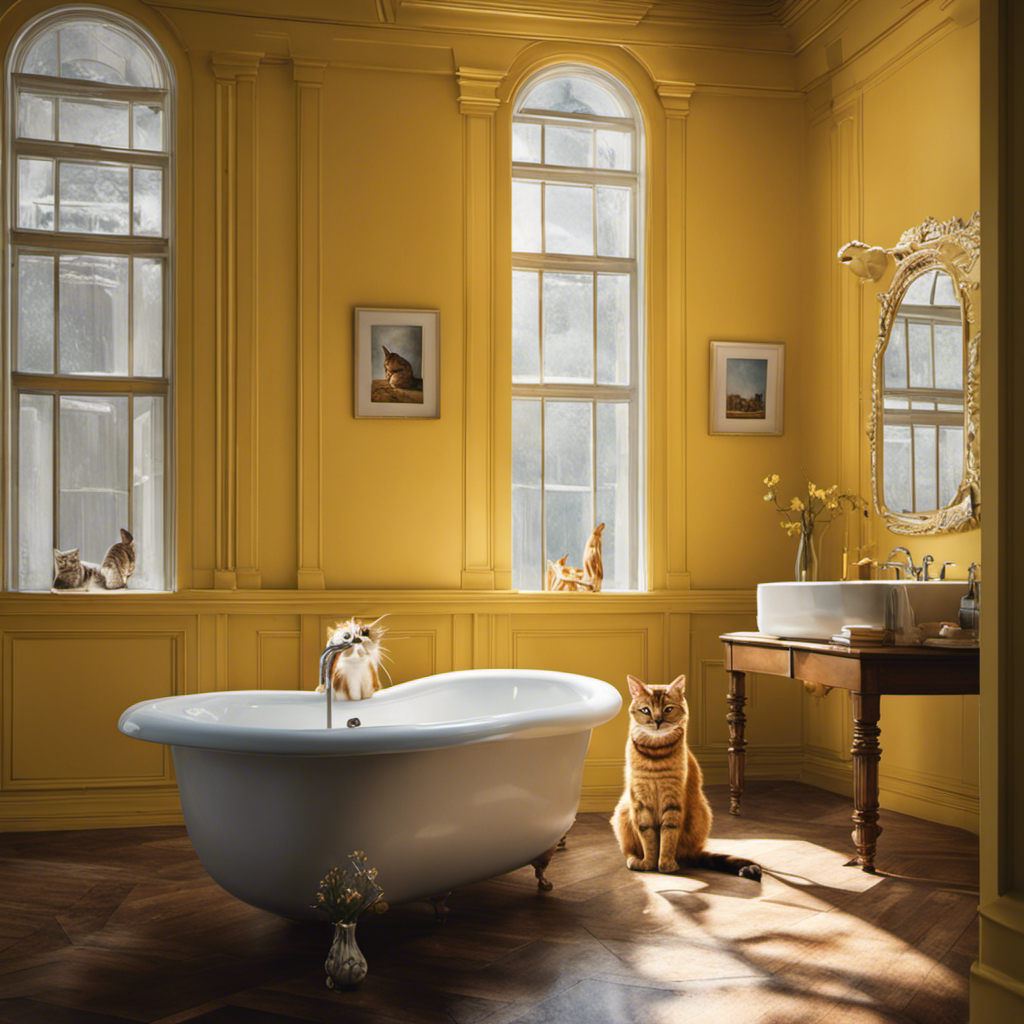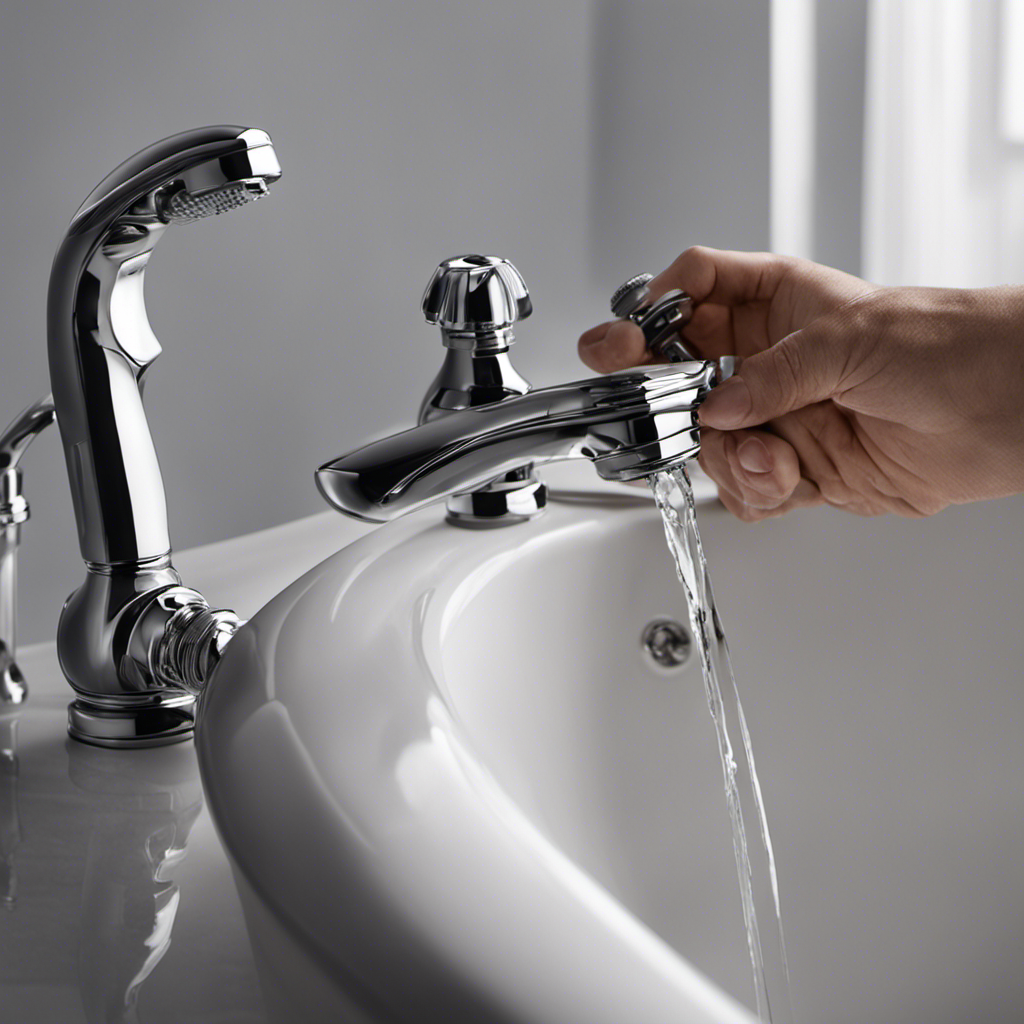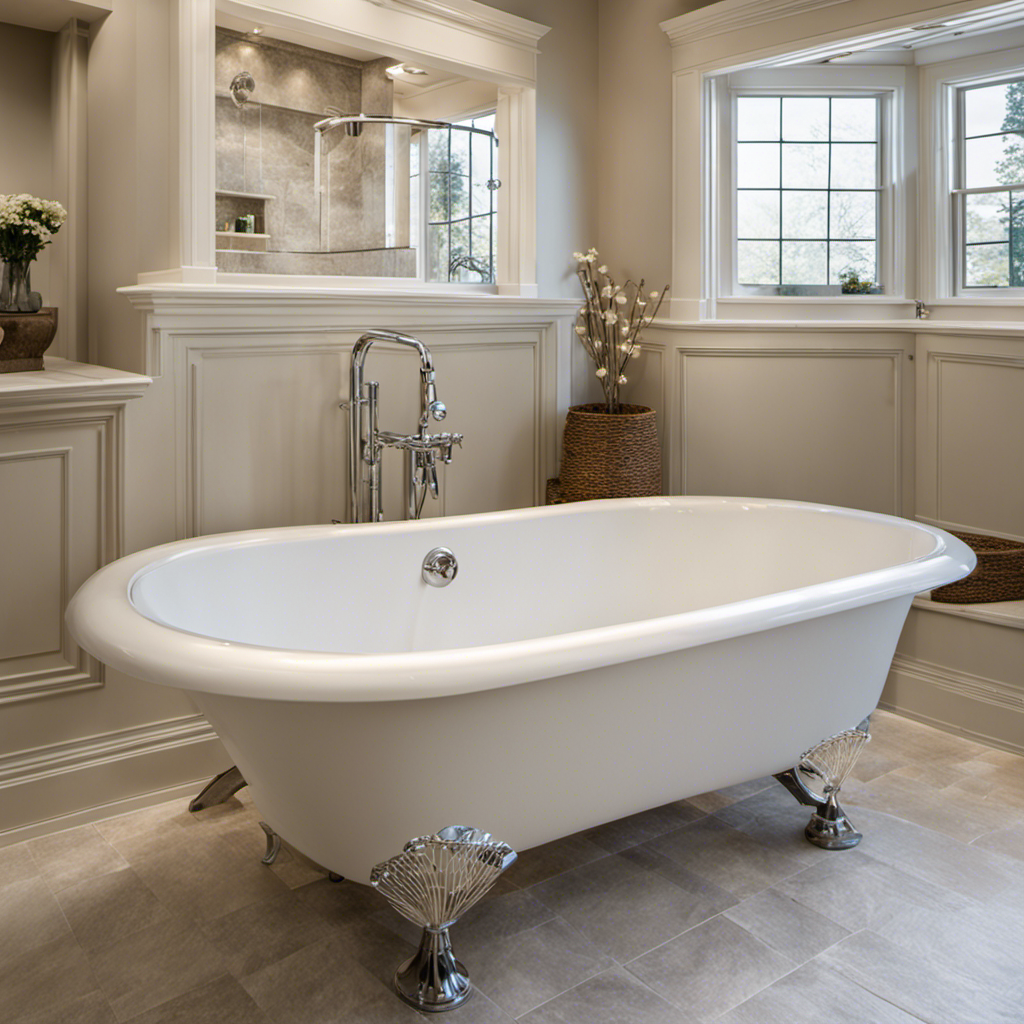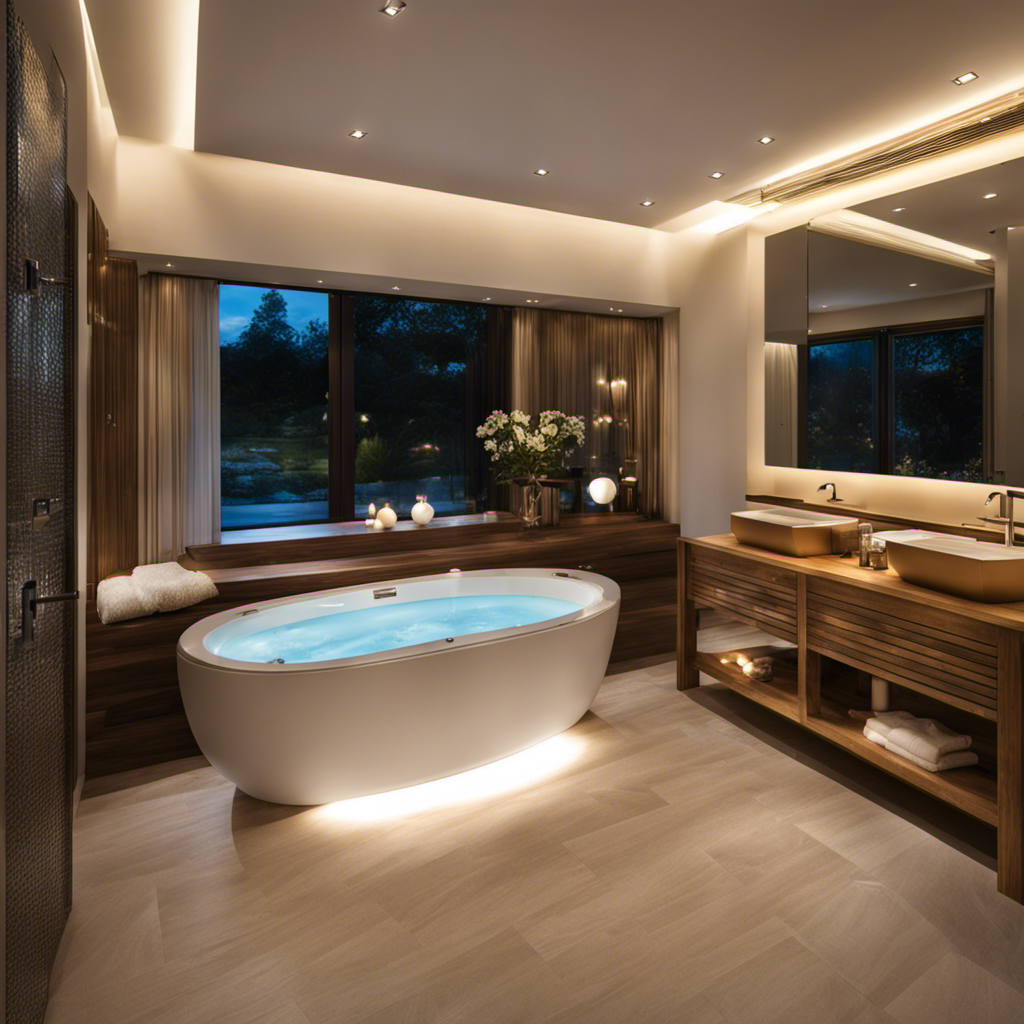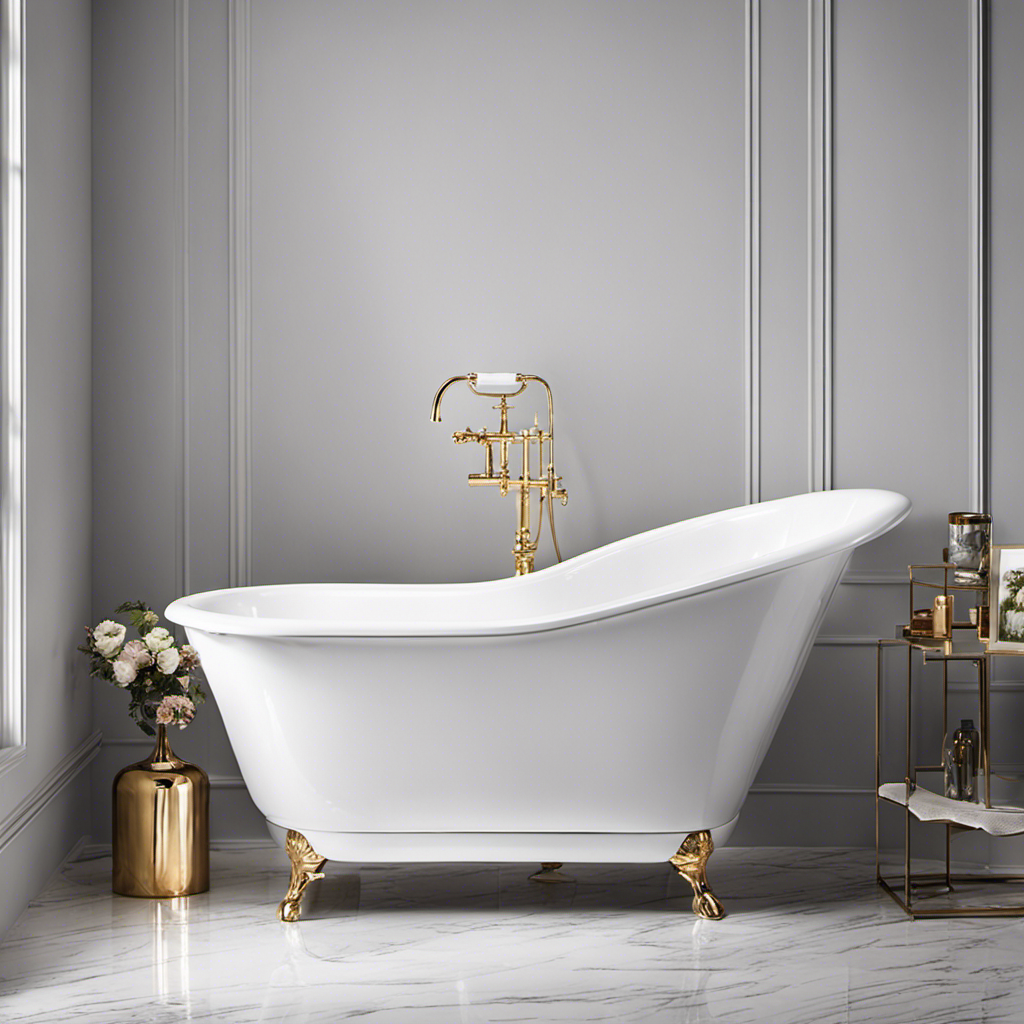Are you puzzled by why your furry feline companion insists on using the bathtub as their personal toilet? You’re not alone. Many cat owners have found themselves in the same predicament, frantically searching for answers.
In this article, we will delve into the possible reasons behind this curious behavior. From potential medical issues to changes in the environment, we will explore the various factors that may be triggering your cat’s unusual bathroom habits.
So, grab a cup of coffee and prepare to unravel the mystery of your cat’s bathtub fascination.
Key Takeaways
- Consistent peeing in the bathtub could indicate potential medical issues in cats such as urinary tract infections (UTIs) and kidney disease, and prompt veterinary consultation is recommended.
- Stress and anxiety can cause changes in a cat’s bathroom habits, including peeing in the bathtub, so addressing and alleviating stress and anxiety can prevent further urinary tract issues.
- Territorial marking is another possible reason for cats peeing in the bathtub, and providing appropriate scratching posts and toys can help prevent this behavior.
- Litter box aversion can contribute to inappropriate urination, so regular cleaning of the litter box and maintaining a comfortable environment are important to prevent aversion.
Potential Medical Issues
If your cat is consistently peeing in the bathtub, it could be a sign of potential medical issues.
One common medical condition that could be causing this behavior is a urinary tract infection (UTI). UTIs can cause discomfort and a frequent urge to urinate, which may lead your cat to seek out alternative places to relieve themselves, such as the bathtub.
It is important to address this issue promptly, as untreated UTIs can lead to more serious complications.
Another possible cause for your cat’s behavior is kidney disease. Cats with kidney disease may experience increased thirst and urination, and the bathtub may provide a cool surface that is appealing for urination.
If your cat is consistently peeing in the bathtub, it is recommended to consult with a veterinarian for proper diagnosis and treatment.
Behavioral Reasons
When it comes to understanding why your cat is peeing in the bathtub, it’s important to consider behavioral reasons.
One possible cause could be stress and anxiety, which can lead to changes in your cat’s bathroom habits.
Another factor to consider is territorial marking, as cats may urinate outside of their litter box to assert their dominance or mark their territory.
Additionally, litter box aversion could be a contributing factor, as some cats may avoid using their litter box if they find it uncomfortable or if it’s not cleaned regularly.
Stress and Anxiety
One possible sentence could be: ‘Stress and anxiety may cause your cat to start peeing in the bathtub.’ Cats are creatures of habit and any change in their environment or routine can lead to stress and anxiety. These emotions can manifest in various ways, including inappropriate urination. When a cat is stressed or anxious, it may seek out alternative places to relieve itself, such as the bathtub. This behavior is often a result of the cat’s natural instinct to mark its territory and establish a sense of security. Additionally, stress and anxiety can also affect the cat’s urinary tract, leading to conditions like feline idiopathic cystitis. It is important to address and alleviate your cat’s stress and anxiety to prevent further urinary tract issues.
| Stress and Anxiety | Effects on Cats | Preventive Measures |
|---|---|---|
| Environmental changes | Inappropriate urination, excessive grooming | Gradual introductions, familiar scents |
| Lack of stimulation | Destructive behavior, aggression | Interactive toys, playtime |
| Social conflicts | Withdrawal, loss of appetite | Separate resources, positive reinforcement |
| Medical conditions | Increased vulnerability to diseases | Regular check-ups, proper nutrition |
| Traumatic experiences | Fearful behavior, avoidance | Gentle handling, patience |
Territorial Marking
To prevent territorial marking, make sure you provide your cat with appropriate scratching posts and toys. Scent marking is a natural behavior in cats, and it serves to establish their territory and communicate with other cats. By providing your cat with scratching posts and toys, you give them an outlet to release their natural instincts and mark their territory in an appropriate way.
Additionally, if you are introducing a new pet to your home, it is important to give your cat time to adjust and establish their territory. This can help reduce the likelihood of territorial marking as your cat feels secure in their environment.
However, if your cat continues to exhibit territorial marking behaviors, it may be an indication of a deeper issue, such as anxiety or stress. This can lead to litter box aversion, which we will explore in the next section.
Litter Box Aversion
Make sure you clean your cat’s litter box regularly to prevent any aversion to using it. Litter box training is an essential aspect of cat ownership, and maintaining a proper cleaning routine is crucial for your cat’s comfort and well-being.
Cats are naturally clean animals, and they have a keen sense of smell. If the litter box is dirty or has a strong odor, your cat may develop an aversion to using it. To avoid this, scoop the litter box daily, and replace the litter every one to two weeks. Regular cleaning helps to maintain a clean and inviting litter box environment for your cat.
However, if your cat continues to avoid the litter box despite proper maintenance, it may be due to changes in the environment that need to be addressed.
Changes in the Environment
If you have recently introduced new furniture into your home, it is possible that this change has caused stress for your cat. Cats are creatures of habit and any disruption to their environment can lead to anxiety and behavioral issues, such as peeing outside the litter box.
Additionally, the location of the litter box plays a crucial role in a cat’s willingness to use it. If the box is not easily accessible or is located in a noisy or high-traffic area, your cat may choose to eliminate elsewhere.
Lastly, recent household renovations can also contribute to a cat’s stress and the subsequent inappropriate elimination. The noise, unfamiliar smells, and overall disruption can lead to confusion and anxiety for your feline companion.
New Furniture Causing Stress
You may want to consider rearranging your new furniture to help alleviate your cat’s stress and prevent them from peeing in the bathtub. Cats are creatures of habit, and any changes in their environment can cause stress and anxiety. Here’s why new furniture placement can lead to cat behavior changes:
-
Disruption of Territory: Cats are territorial animals, and any changes in their territory can be unsettling. Moving furniture can disrupt their sense of familiarity and security, leading to stress and anxiety.
-
Lack of Escape Routes: Cats need to feel safe and secure in their environment. If the new furniture obstructs their usual escape routes, such as hiding spots or high perches, they may feel trapped and resort to inappropriate elimination, like peeing in the bathtub.
-
Scent Marking: Cats have scent glands in their paws and face. When furniture is moved, it can disturb their scent markings, causing them to feel the need to re-mark their territory by urinating in unusual places.
Litter Box Location Issue
Moving the litter box to a more accessible location could help address the issue of inappropriate elimination. Cats are creatures of habit and prefer a clean and easily accessible litter box. By placing the litter box in a convenient location, you can encourage your cat to use it consistently and prevent accidents in undesirable areas like the bathtub.
To better understand the importance of litter box location, consider the following table:
| Litter Box Location | Pros | Cons |
|---|---|---|
| Basement | Provides privacy and separation | May be inconvenient for older cats |
| Bathroom | Easy access and convenient | May be noisy or busy |
| Laundry room | Quiet and secluded | May have strong smells or vibrations |
| Bedroom | Allows close monitoring of the cat | May disturb sleep or personal space |
| Living room | Central location, easy to clean | May not offer enough privacy |
Recent Household Renovations?
After recent household renovations, it’s important to consider finding a new location for the litter box that is easily accessible for your cat. Cats are creatures of habit, and any changes to their environment can cause stress and anxiety. Here are three reasons why recent home improvements might be causing litter box problems for your cat:
-
Plumbing issues: If your renovations involved plumbing work, the noise and disruption could have scared your cat away from using the litter box in its usual location.
-
Change in access: Renovations may have altered the layout of your home, making it difficult for your cat to reach the litter box. Cats prefer privacy and convenience when it comes to their bathroom habits.
-
Odor and cleanliness: Dust, debris, and lingering smells from the renovations can make your cat reluctant to use a litter box that doesn’t meet their standards of cleanliness.
Considering these factors, it’s important to address any litter box problems that have arisen after recent home improvements.
Litter Box Problems
If your cat’s litter box is not cleaned regularly, they may start peeing in the bathtub. Litter box training is an essential aspect of cat ownership. Cats have an instinctual need to eliminate in a specific area, and the litter box serves as their designated spot. Proper litter box maintenance is crucial to ensure your cat’s satisfaction and prevent unwanted behaviors like peeing outside the box.
Scooping the litter box daily and completely changing the litter at least once a week is recommended. Additionally, providing multiple litter boxes in different areas of your home can increase your cat’s access to a clean and accessible toilet. By following these litter box maintenance guidelines, you can minimize the chances of your cat peeing in the bathtub and promote a healthy elimination routine.
However, if your cat continues to exhibit this behavior, it may be a sign of stress and anxiety.
Stress and Anxiety
Cats can experience stress and anxiety, which may lead to behavioral issues like peeing outside of the litter box. It’s important to understand that cats are sensitive creatures and can easily become overwhelmed.
By implementing stress management techniques, you can help your feline friend find relief and reduce the likelihood of bathroom accidents.
Here are three relaxation techniques that can help your cat manage stress:
-
Provide a safe and quiet space: Create a designated area where your cat can retreat to when feeling stressed. This space should be quiet, comfortable, and away from any potential triggers.
-
Use pheromone diffusers: Pheromone diffusers emit synthetic versions of naturally occurring chemicals that help cats feel calm and secure. Placing these diffusers in areas where your cat spends most of their time can promote relaxation.
-
Engage in play and exercise: Regular playtime and exercise sessions can help your cat release pent-up energy and reduce stress. Interactive toys, laser pointers, and puzzle feeders are great options to keep your cat mentally and physically stimulated.
Marking Territory
To prevent territorial marking, make sure to provide your feline friend with plenty of vertical spaces, such as tall cat trees and shelves. Cats have a natural instinct to mark their territory, especially when they feel threatened or want to establish dominance. Marking behavior can often lead to territorial disputes between cats in the same household. By providing your cat with vertical spaces, you are giving them the opportunity to climb and observe their surroundings, which helps them feel more secure and in control of their territory. Here is an example of a vertical space setup for your cat:
| Cat Tree | Wall-Mounted Shelves |
|---|---|
| Multiple levels for climbing and perching | Elevated resting spots |
| Scratching posts for territorial scent marking | Safe and secure hiding spots |
| Soft and comfortable surfaces | Easy access to windows and high vantage points |
These vertical spaces not only fulfill your cat’s natural need for height, but also provide them with a sense of ownership over their territory, reducing the likelihood of marking behavior and territorial disputes.
Aging and Senior Cats
As cats age, their mobility and energy levels may decrease, leading to a need for modifications in their environment to ensure their comfort and safety. Aging cats may face various challenges, including memory decline and joint pain.
Here are three important considerations to keep in mind when caring for your senior feline companion:
-
Provide easy access: As cats age, they may find it difficult to jump onto high surfaces or navigate stairs. Ensure they have access to their favorite spots by providing ramps or steps to help them reach elevated areas.
-
Comfortable resting areas: Senior cats often require more rest to recover from their daily activities. Provide soft, supportive bedding in warm and cozy areas to alleviate any discomfort they may experience due to joint pain.
-
Mental stimulation: Aging cats may experience memory decline. Engage them with interactive toys, puzzles, and games to keep their minds sharp and provide mental stimulation.
Frequently Asked Questions
How Can I Prevent My Cat From Peeing in the Bathtub?
To prevent your cat from peeing in the bathtub, focus on litter box training and behavior modification techniques. Understand that cats may avoid the litter box due to stress, medical issues, or dislike of their current setup.
Is It Normal for Cats to Pee in the Bathtub?
Is it normal for cats to pee in the bathtub? No, it’s not. Inappropriate urination can have various causes, such as medical issues or litter box problems. Training your cat to use the litter box correctly is essential.
Can Stress Cause a Cat to Start Peeing in the Bathtub?
Stress can indeed cause a cat to start peeing in the bathtub. Ensuring the litter box is easily accessible and placed in a quiet, low-traffic area can help prevent this behavior. Environmental enrichment can also reduce stress and decrease bathtub peeing.
Are There Any Home Remedies to Stop My Cat From Peeing in the Bathtub?
To stop your cat from peeing in the bathtub, try these home remedies. First, make sure the litter box is clean and accessible. Provide multiple litter boxes and try different types of litter. Observe your cat’s behavior and consult a veterinarian if the issue persists.
Can a Cat’s Diet Affect Their Bathroom Habits and Lead to Peeing in the Bathtub?
Dietary changes can indeed affect a cat’s bathroom habits, leading to peeing in the bathtub. It’s important to ensure a balanced diet and proper litter box training to address this issue.
Conclusion
In conclusion, if your cat is peeing in the bathtub, it’s important to consider both medical and behavioral factors.
It could be due to a urinary tract infection or other health issues, so consulting a vet is crucial.
Changes in the environment, litter box problems, stress, and anxiety can also lead to this behavior.
As cats age, they may have difficulty reaching the litter box, so providing easy access and comfort is essential.
Remember, understanding your cat’s needs and addressing them promptly will ensure a harmonious and clean home environment.
